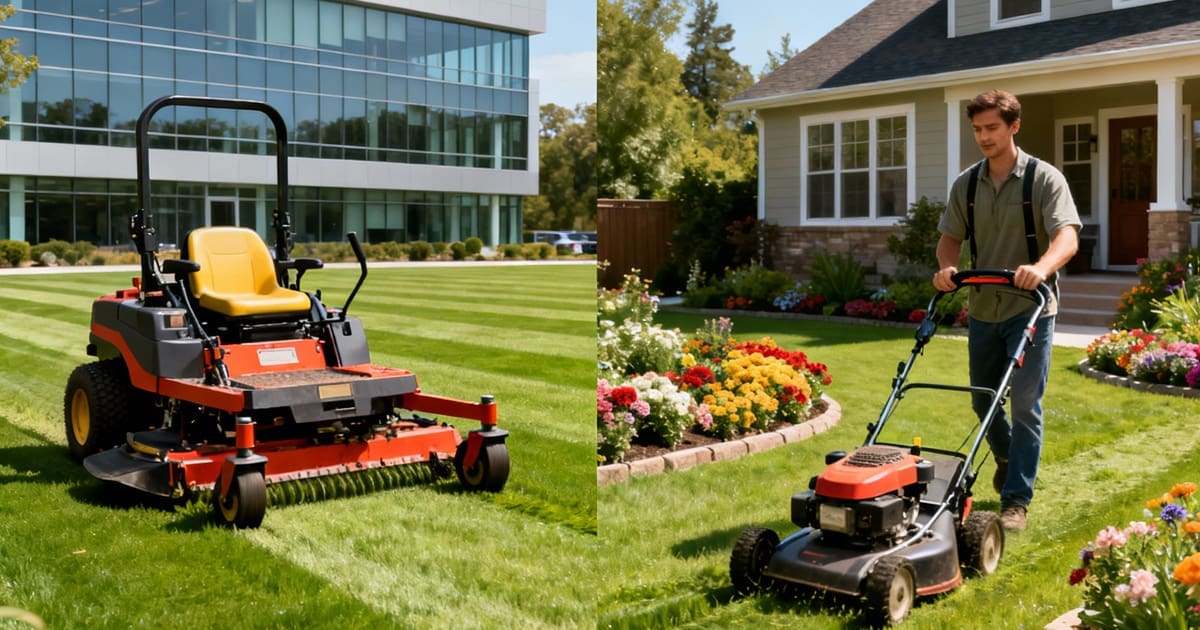At 4 Seasons Grounds & Landscaping Solutions, we’ve worked with both commercial and residential clients for over a decade. The differences between these two sectors run deeper than you might expect. Understanding these distinctions helps property owners make informed decisions about their grass-cutting needs.
Scale and Equipment Requirements
Residential Properties
Most homes have lawns ranging from 200 to 2,000 square metres. We typically use walk-behind mowers or ride-on machines for these spaces. Standard equipment includes 21-inch push mowers for tight areas and 42-inch riding mowers for larger gardens.
The terrain varies widely in residential settings. Gardens often feature flower beds, trees, and decorative elements. This requires careful navigation and attention to detail around obstacles.
Commercial Properties
Commercial sites present a distinct challenge. Office parks might span 50,000 square metres or more. Sports facilities can exceed 100,000 square metres. These spaces demand industrial-grade equipment.
We deploy zero-turn mowers with 60-inch cutting decks for open areas. Wide-area mowers handle large expanses efficiently. Gang mowers work well for sports fields and golf courses. The equipment investment for commercial work runs into tens of thousands of pounds.
Timing and Scheduling Constraints
Residential Flexibility
Homeowners usually prefer weekend or evening appointments. School holidays typically do not affect residential schedules. Weather delays can be managed with makeup visits the following week.
Most residential clients accept a flexible approach to timing. If rain postpones Monday’s cut, Tuesday works just as well. This flexibility allows for optimal grass cutting conditions.
Commercial Demands
Business properties operate on strict schedules. Retail centres need to maintain pristine appearances before the weekend shopping peaks. Office complexes require maintenance outside business hours to avoid disrupting employees.
Sports facilities have match schedules that cannot be moved. School grounds need to be cut between term times or during specific hours. These constraints often mean working early mornings, evenings, or weekends.
Weather delays create significant challenges in commercial work. Missing a scheduled cut before a sporting event or business presentation isn’t acceptable. We maintain backup equipment and additional crew capacity for such situations.
Regulatory and Safety Considerations
Residential Standards
Home gardens follow basic health and safety guidelines. We ensure proper equipment maintenance and safe working practices. Insurance requirements are straightforward.
Environmental considerations include protecting flower beds and avoiding damage to garden features. Noise restrictions typically apply during early morning or late evening hours.
Commercial Compliance
Commercial sites involve complex regulations. Health and Safety Executive (HSE) requirements are stringent. Risk assessments must be comprehensive and regularly updated to ensure accuracy and effectiveness.
Public liability insurance needs are higher for commercial work. Some sites require specific certifications or security clearances. Construction sites demand additional safety protocols and equipment.
Environmental regulations are stricter for commercial properties. Waste disposal follows commercial guidelines. Some sites have specific environmental management systems we must follow.
Cost Structure and Pricing Models
Residential Pricing
Home grass cutting typically uses per-visit pricing. Costs range from £25 for small gardens to £150 for large properties. Seasonal contracts offer better value for both parties.
Payment terms are usually monthly or per-service. Direct debit arrangements work well for regular customers. Seasonal variations affect pricing, with winter months often excluded.
Commercial Calculations
Commercial pricing considers multiple factors beyond square meterage. Access difficulties, scheduling constraints, and equipment requirements all influence costs.
Contract values range from hundreds to thousands of pounds monthly. Long-term agreements spanning multiple years are common. Payment terms often extend to 30 days, which can impact cash flow management.
Volume discounts are available for large sites or multiple properties. Seasonal variations are less pronounced, as many commercial sites require year-round maintenance.
Quality Standards and Expectations
Residential Requirements
Homeowners value personal attention and care for their property. They notice details like edge trimming and leaf cleanup. Communication is often direct with the property owner.
Expectations focus on aesthetic appeal and garden health. Seasonal advice and plant care suggestions are appreciated. Flexibility in service delivery is generally welcomed.
Commercial Excellence
Business clients demand consistent, professional results. Standards must be maintained regardless of weather or seasonal conditions. Multiple stakeholders often evaluate our work.
Brand image considerations mean appearance standards are non-negotiable. Retail environments need perfect presentation at all times. Office complexes reflect on the businesses they house.
Documentation becomes important for commercial clients. Progress reports, maintenance schedules, and compliance certificates may be required. Professional communication through designated contacts is essential.
Seasonal Considerations
Residential Adaptability
Home gardens follow natural seasonal patterns. Spring brings intensive growth requiring weekly cuts. Summer maintenance continues regularly. Autumn focuses on leaf clearance and final cuts before winter.
Winter months typically see reduced or suspended service. Garden preparation for spring becomes important. Seasonal cleanups and preparation work fill the quieter periods.
Commercial Continuity
Business properties often require year-round attention. Retail centres require a consistent appearance, regardless of the season. Sports facilities have specific seasonal requirements tied to their usage patterns.
Winter work might include snow clearance and pathway maintenance. Seasonal decorations and special events require additional services. Planning for year-round operations affects staffing and equipment needs.
Technology and Innovation
Residential Applications
Smart home integration is growing in residential settings. GPS tracking for service confirmation appeals to homeowners. Simple scheduling apps work well for residential clients.
Robotic mowers are gaining acceptance for regular maintenance between professional visits. Environmental monitoring helps optimise cutting schedules.
Commercial Solutions
Commercial sites benefit from advanced fleet management systems. GPS tracking ensures security compliance and provides detailed service records. Automated reporting systems feed into facility management platforms.
Drone surveys aid in planning maintenance for large sites. Weather monitoring systems optimise scheduling across multiple properties. Professional-grade software manages complex scheduling requirements.
Making the Right Choice
Understanding these differences helps property owners select appropriate service providers. Residential clients should seek companies that offer personal service and flexibility. Commercial property managers need providers with proper equipment, certifications, and systematic approaches.
At 4 Seasons Grounds & Landscaping Solutions, we’ve structured our services to excel in both sectors. Our residential team focuses on personal service and garden care. Our commercial division handles complex sites with professional equipment and procedures.
The investment in proper equipment, training, and systems allows us to deliver appropriate service levels for each sector. Whether you’re maintaining a family garden or managing a business park, understanding these key differences ensures you receive the right service for your needs.

